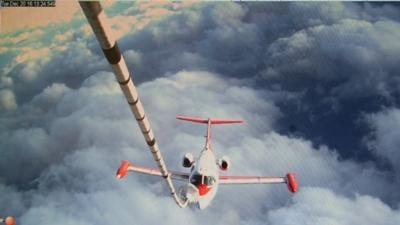Wed, Jan 25, 2012
System Under Development That Could Significantly Increase The
Endurance And Range Of Carrier-Based Unmanned Aircraft
As part of the Unmanned Combat Air System Demonstration (UCAS-D)
program, the Navy and industry partner Northrop Grumman have been
developing Autonomous Aerial Refueling (AAR) technologies to refuel
unmanned aircraft in flight. The team completed a series of flight
tests Jan.21 in St. Augustine, FL, as the latest step toward
demonstrating unmanned AAR capability.
Image Provided By NAVAIR

“The AAR segment of the program is intended to demonstrate
a system that will enable the X-47B UCAS-D to safely approach and
maneuver around tanker aircraft, performing both Navy and Air Force
style refueling techniques,” said Capt. Jaime Engdahl, Navy
UCAS program manager.
The Navy has been working closely with the Air Force Research
Lab for the past decade to develop technologies and operating
concepts for AAR, Engdahl said. Both services share a common goal
of enabling tankers to autonomously refuel manned and unmanned
aircraft in the future, he added.
The UCAS-D team began this test phase in November when a team
from Northrop Grumman installed X-47B hardware and software on a
Calspan Learjet surrogate aircraft. The initial ground and taxi
tests culminated in the first AAR test flight Dec. 20. The team
then conducted a series of flights using the surrogate aircraft,
equipped with X-47B software and hardware, and an Omega K-707
Tanker. The Learjet successfully completed multiple air-refueling
test points autonomously while commanded by a ground operator.
The AAR segment of the UCAS-D program is designed to assess the
initial functionality of the X-47B AAR systems and navigation
performance, as well as to test the government tanker refueling
interface systems. The AAR program is using similar command and
control, and navigation processes being demonstrated by the UCAS
team aboard the aircraft carrier. “The next big step for the
program is to demonstrate this capability with the unmanned X-47B
and actually plug the aircraft autonomously,” Engdahl said.
“The AAR team did an exceptional job executing flight test in
St. Augustine. The team’s' ability to successfully complete
these test maneuvers so early in the program is a significant
learning event and reduces risk for the future."
The team plans to conduct two more surrogate test periods before
demonstrating refueling techniques on the X-47B in 2014. Data from
the tests will be used to assess system performance, demonstrate
viability of the AAR concept and develop operational procedures to
support further development of future unmanned systems. "By adding
an autonomous aerial refueling capability to unmanned aircraft, we
can significantly increase their range, persistence and overall
flexibility," added Engdahl, who said he is very impressed with the
system’s performance. “This is a game-changer for naval
aviation and is critical for our success with unmanned long range
aircraft in the future.”
More News
Pilot Applied Full Aft Stick And Nose-Up Trim, But The Airplane Remained On The Runway Analysis: The pilot reported that a preflight inspection and flight control checks revealed n>[...]
A Few Questions AND Answers To Help You Get MORE Out of ANN! 1) I forgot my password. How do I find it? 1) Easy... click here and give us your e-mail address--we'll send it to you >[...]
From 2022 (YouTube Edition): Before They’re All Gone... Humankind has been messing about in airplanes for almost 120-years. In that time, thousands of aircraft representing i>[...]
Advanced Air Mobility (AAM) A transportation system that transports people and property by air between two points in the NAS using aircraft with advanced technologies, including el>[...]
Aero Linx: MQ-1B Predator The MQ-1B Predator is an armed, multi-mission, medium-altitude, long-endurance remotely piloted aircraft that is employed primarily as an intelligence-col>[...]
 NTSB Final Report: Douglas A-4K
NTSB Final Report: Douglas A-4K ANN FAQ: Q&A 101
ANN FAQ: Q&A 101 Classic Aero-TV: PBY Catalina--From Wartime to Double Sunrise to the Long Sunset
Classic Aero-TV: PBY Catalina--From Wartime to Double Sunrise to the Long Sunset ANN's Daily Aero-Term (07.01.25): Advanced Air Mobility (AAM)
ANN's Daily Aero-Term (07.01.25): Advanced Air Mobility (AAM) ANN's Daily Aero-Linx (07.01.25)
ANN's Daily Aero-Linx (07.01.25)



